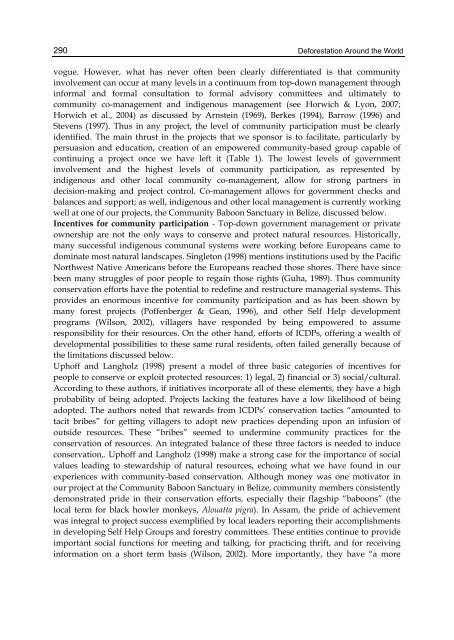DEFORESTATION AROUND THE WORLD - India Environment Portal
DEFORESTATION AROUND THE WORLD - India Environment Portal
DEFORESTATION AROUND THE WORLD - India Environment Portal
You also want an ePaper? Increase the reach of your titles
YUMPU automatically turns print PDFs into web optimized ePapers that Google loves.
290<br />
Deforestation Around the World<br />
vogue. However, what has never often been clearly differentiated is that community<br />
involvement can occur at many levels in a continuum from top-down management through<br />
informal and formal consultation to formal advisory committees and ultimately to<br />
community co-management and indigenous management (see Horwich & Lyon, 2007;<br />
Horwich et al., 2004) as discussed by Arnstein (1969), Berkes (1994), Barrow (1996) and<br />
Stevens (1997). Thus in any project, the level of community participation must be clearly<br />
identified. The main thrust in the projects that we sponsor is to facilitate, particularly by<br />
persuasion and education, creation of an empowered community-based group capable of<br />
continuing a project once we have left it (Table 1). The lowest levels of government<br />
involvement and the highest levels of community participation, as represented by<br />
indigenous and other local community co-management, allow for strong partners in<br />
decision-making and project control. Co-management allows for government checks and<br />
balances and support; as well, indigenous and other local management is currently working<br />
well at one of our projects, the Community Baboon Sanctuary in Belize, discussed below.<br />
Incentives for community participation - Top-down government management or private<br />
ownership are not the only ways to conserve and protect natural resources. Historically,<br />
many successful indigenous communal systems were working before Europeans came to<br />
dominate most natural landscapes. Singleton (1998) mentions institutions used by the Pacific<br />
Northwest Native Americans before the Europeans reached those shores. There have since<br />
been many struggles of poor people to regain those rights (Guha, 1989). Thus community<br />
conservation efforts have the potential to redefine and restructure managerial systems. This<br />
provides an enormous incentive for community participation and as has been shown by<br />
many forest projects (Poffenberger & Gean, 1996), and other Self Help development<br />
programs (Wilson, 2002), villagers have responded by being empowered to assume<br />
responsibility for their resources. On the other hand, efforts of ICDPs, offering a wealth of<br />
developmental possibilities to these same rural residents, often failed generally because of<br />
the limitations discussed below.<br />
Uphoff and Langholz (1998) present a model of three basic categories of incentives for<br />
people to conserve or exploit protected resources: 1) legal, 2) financial or 3) social/cultural.<br />
According to these authors, if initiatives incorporate all of these elements, they have a high<br />
probability of being adopted. Projects lacking the features have a low likelihood of being<br />
adopted. The authors noted that rewards from ICDPs’ conservation tactics “amounted to<br />
tacit bribes” for getting villagers to adopt new practices depending upon an infusion of<br />
outside resources. These “bribes” seemed to undermine community practices for the<br />
conservation of resources. An integrated balance of these three factors is needed to induce<br />
conservation,. Uphoff and Langholz (1998) make a strong case for the importance of social<br />
values leading to stewardship of natural resources, echoing what we have found in our<br />
experiences with community-based conservation. Although money was one motivator in<br />
our project at the Community Baboon Sanctuary in Belize, community members consistently<br />
demonstrated pride in their conservation efforts, especially their flagship “baboons” (the<br />
local term for black howler monkeys, Alouatta pigra). In Assam, the pride of achievement<br />
was integral to project success exemplified by local leaders reporting their accomplishments<br />
in developing Self Help Groups and forestry committees. These entities continue to provide<br />
important social functions for meeting and talking, for practicing thrift, and for receiving<br />
information on a short term basis (Wilson, 2002). More importantly, they have “a more

















